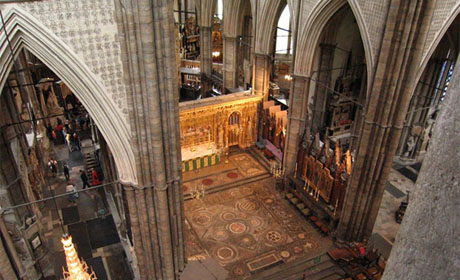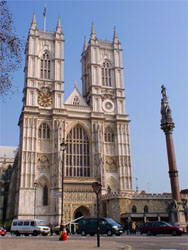Westminster Abbey
London, England

The Sanctuary Pavement of Westminster Abbey lies at the heart of the Abbey church envisioned and created by Kind Henry III in the late 13th Century and features a variety of beautiful stones.
 Designed to commemorate the translation of the bones of St Edward the Confessor from the crypt to a new shrine (situated behind the High Altar) the pavement is in the Cosmatesque style which had been popular in Rome over the preceding two centuries.
Designed to commemorate the translation of the bones of St Edward the Confessor from the crypt to a new shrine (situated behind the High Altar) the pavement is in the Cosmatesque style which had been popular in Rome over the preceding two centuries.
Cosmatesque floors may be described as a ‘patchwork quilt’ of stones. Unlike mosaic where the stone pieces are all small cubes, Cosmatesque designs feature stones of different shapes fitted together to make a pattern. The materials used in Cosmati work were decorative stones (marbles and porphyries) and glass laid in a bed of mortar. Typically it appears that stones were ‘acquired’ from Roman-period archaeological sites and recut to form pieces.
 The decorative building stones used in the Abbey include Pubeck marble, green and purple porphyry, africano (red and black marble breccias), alabaster, Ammontico Rosso, Black Coralline Limestone, Breccia Corallina, Carrara Marble, Egyptican Gabbro, Tadcaster Limestone and Verde Genova, a green serpentinite.
The decorative building stones used in the Abbey include Pubeck marble, green and purple porphyry, africano (red and black marble breccias), alabaster, Ammontico Rosso, Black Coralline Limestone, Breccia Corallina, Carrara Marble, Egyptican Gabbro, Tadcaster Limestone and Verde Genova, a green serpentinite.
Watch the British Geological Survey's video to find out more about building stones:
Related Links
The stones of Westminster Abbey (Ruth Siddall)

Images (top to bottom):
- The Cosmati Pavement in front of the High Altar © Ruth Siddall
- Westminster Abbey © Σπάρτακος, (Source: Wikimedia Commons) Creative Commons Attribution-Share Alike 3.0 Unported
- Decorative stones including green and purple porphyry © Ruth Siddall
- Close-up of pavement © Ruth Siddall

October 13 - 21
Theme: 'Earth Science in our lives'
